Recent Articles
Popular Makes
Body Types
2024 Toyota Prius Road Test and Review
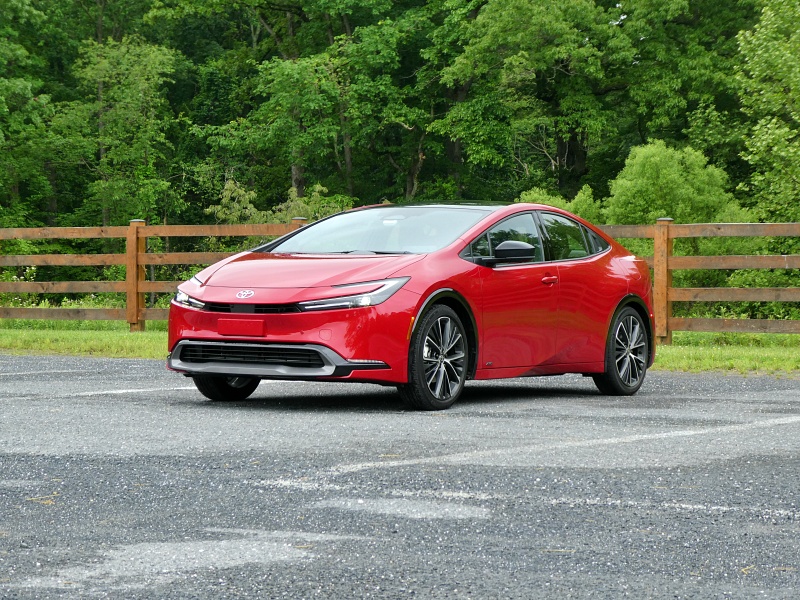
2024 Toyota Prius Limited ・ Photo by Brady Holt
It’s been a while since the Toyota Prius was cool. Back in 2004, celebrities lined up to buy this uniquely styled, cutting-edge fuel-saving machine. But over time, the iconic hybrid faded into a sensible if dorky-looking hatchback that you buy when gas mileage is at the top of your priority list.
Last year, Toyota “reimagined” the Prius experience with a full redesign. Its new body is sports-car sharp, complemented by an upgraded suspension and a new powertrain that makes nearly 200 horsepower. Yet it’s still a remarkable fuel-saver with EPA ratings of up to 57 mpg in mixed driving and no need to plug it in. And it still comes with lots of standard features at a base price of $27,950. We just spent a week testing the 2024 Prius to see how its promise measures up – and what was lost along the way.
Sporty Style
The latest Prius is one of the most beautiful small cars on the market today. That’s a remarkable turnaround for a car whose previous design ethos prioritized elaborate wedges, creases, and other shapes over simple elegance.
For 2023, Toyota made the Prius lower and wider, and it smoothed out the details. The headlights became crisp C-shapes that merge into a small grille. The hood flows smoothly into the windshield, good news for both style and aerodynamics. The smaller side windows, hidden rear doorhandles, and rear lightbar further give the Prius the stance of a sports coupe. And our test vehicle’s flashy 19-inch wheels are standard on all but the base LE model, which wears 17-inchers; by contrast, the previous-generation Prius started with 15-inch wheels with 17-inchers on upper trim levels. A stranger came up to us to gush about the new design, and said he’s been telling friends that they should give the Prius another look.
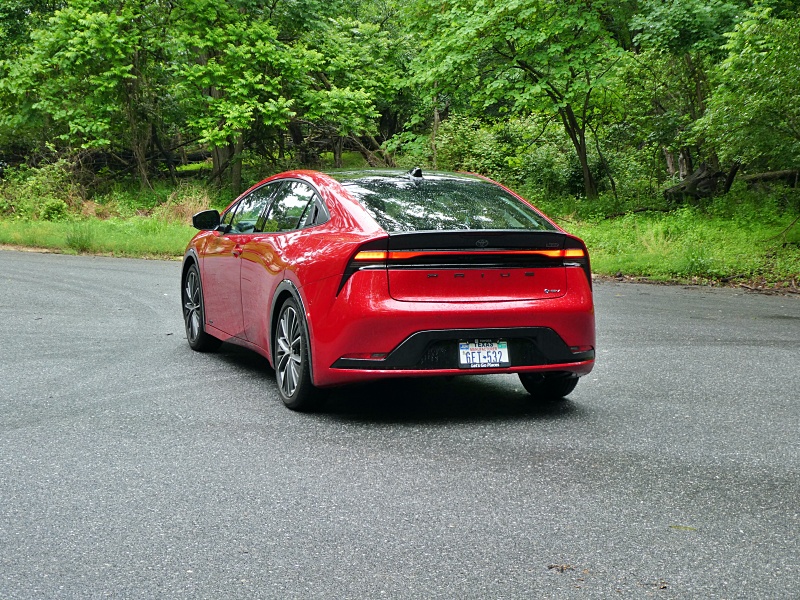
2024 Toyota Prius Limited ・ Photo by Brady Holt
Great Mileage, and Now Featuring Speed
The Prius’s beautiful styling would be almost a disappointment if Toyota hadn’t also improved the car’s performance. The previous-generation Prius made a mere 121 horsepower from the combination of its gas engine and electric motor, which were enough to propel it to 60 mph in about 10 seconds. That’s enough to keep up with traffic, but the engine made a lot of noise to do so. Now, the 2024 Prius makes 194 to 196 hp depending on the version, and 60 mph arrives in just 7 seconds. That elevates it from the bottom tier of the compact-car class to the upper tier. The engine still isn’t quiet or rich-sounding, so you won’t enjoy the speed as much. But at least this little hybrid can finally go.
Better still, despite the extra speed, its EPA fuel economy estimates improved by about 1 mpg. Most trim levels manage 52 mpg in both city and highway driving. The base front-wheel-drive LE improves to 57 mpg city and 56 mpg highway. And all-wheel drive, available on all trim levels, costs 3 mpg. On our AWD Limited test vehicle, that comes to 49 mpg city, 50 mpg highway, and 49 mpg combined. We matched that average during our weeklong test, and we got 55 mpg from a front-drive Limited last year. Still, we did even better in our real-world but non-scientific tests of multiple previous-generation Priuses.
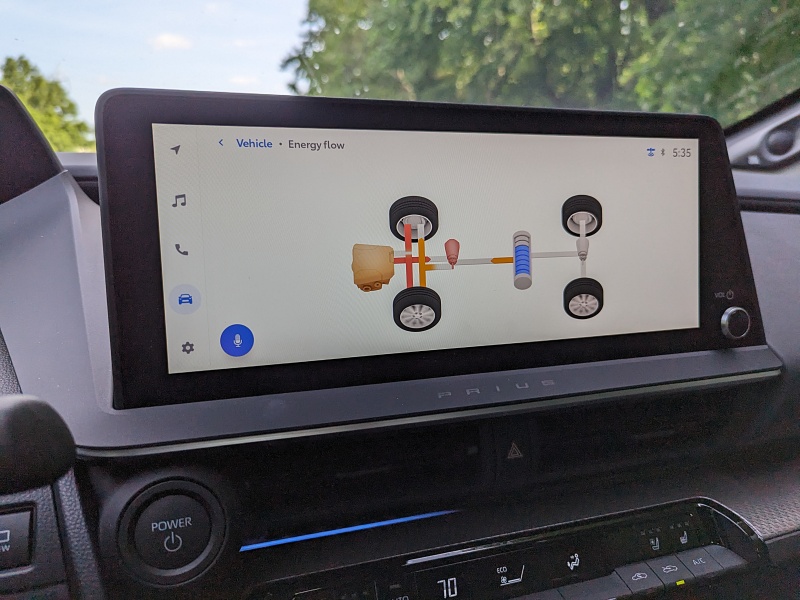
2024 Toyota Prius Limited ・ Photo by Brady Holt
More Refined Ride
Toyota has also been steadily improving the Prius’s ride and handling, and that effort continues with the latest model. Early Priuses were bumpy, buzzy economy cars, but each subsequent generation has improved upon that point. It developed a cushier ride in 2010, more agile handling in 2016, and now a greater overall sense of polish and sophistication for starting last year.
We already mentioned that the new Prius’s engine got more powerful. And while it’s still on the loud side, it’s no longer wheezy and strained when you push it. This goes a long way toward improving the car’s overall sense of refinement. But we also appreciated the way the suspension absorbs bumps solidly, avoiding harsh slams or flimsy shudders. And while we wouldn’t call the steering and handling sports-car crisp, it’s less disconnected than on ancient-past Priuses. The Prius’s improved performance still won’t tempt driving enthusiasts out of their Mazda3s and Volkswagen GTIs. Push it into a corner, and the steering goes numb. But if enthusiasts are looking to halve their fuel bills, the Prius is more tolerable than before.
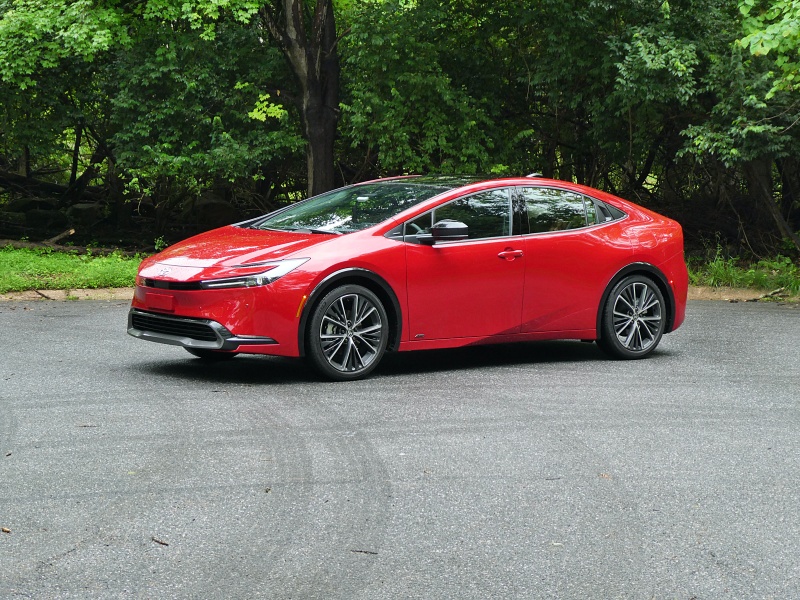
2024 Toyota Prius Limited ・ Photo by Brady Holt
Still an Unconventional Dashboard
While the Prius’s exterior has abandoned its funky look in favor of traditional good looks, the cabin remains forcefully unconventional. The main weirdness involves the steering wheel and gauge cluster, in a design scheme shared with the more thoroughly weird Toyota bZ4x. While the speedometer no longer sits in the center of the dash like in old Priuses, you’re now supposed to position the steering wheel to see the instruments over the steering wheel rim.
The rest of the Prius’s interior is more normal. There’s an upgraded touchscreen in the dashboard that measures 8 inches on base Priuses and 12.3 inches on uplevel models like our test vehicle. Importantly, there are also physical buttons and knobs for basic functions. We do wish Toyota had done more with the massive screen real estate, though; it just stretches a single view like radio information or the GPS map all the way across, rather than splitting the screen to show both. And while you can put some extra info on the gauge cluster, it still wasn’t enough to track our gas mileage, electric battery capacity, and radio information all at the same time. The interior materials aren’t ritzy for a car that topped $35,000 as tested, but it’s nothing disastrous.
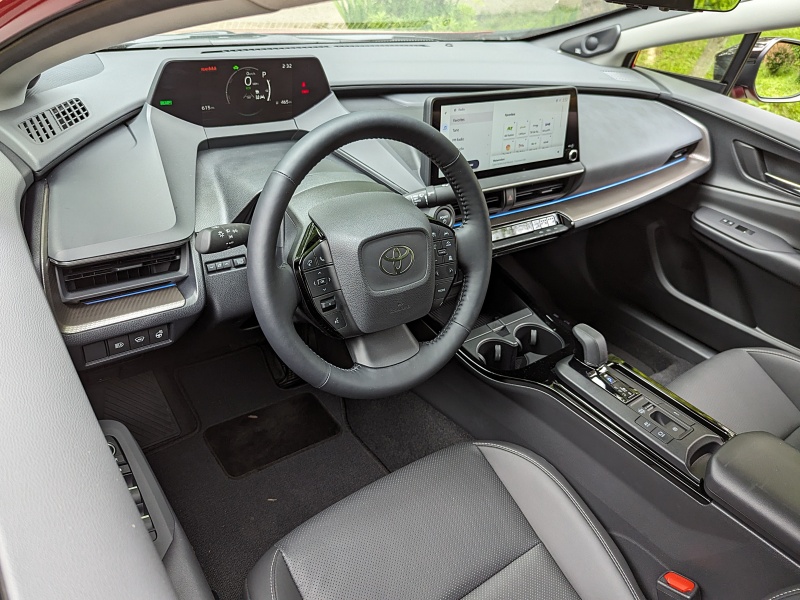
2024 Toyota Prius Limited ・ Photo by Brady Holt
Cozier Cabin
We’ve mentioned how the Prius got lower, wider, and sleeker. That’s great for its cool factor, but it’s not ideal if you once loved this hybrid for its functionality. Whether you were using it as a family car, an Uber, or a king of the carpool, you could count on previous Prius generations to offer big backseats and cargo holds.
The 2024 model is a snugger fit. Everyone should still be fine in the driver’s seat if they don’t mind sitting low. That’s great news if you’re trying to avoid an SUV feel, but it means bending down more to get in and out. It’s also harder to see out of the Prius’s stylishly small windows, and the car’s classic two-piece rear windshield is gone as well. There’s no longer even a rear windshield wiper. And while adults can still fit into the backseat about as well as they do in a Toyota Corolla Hybrid, they have less legroom and headroom than an older Prius. Also, some rear passengers will struggle to find the Prius’s exterior door handles, which hide up by the window.
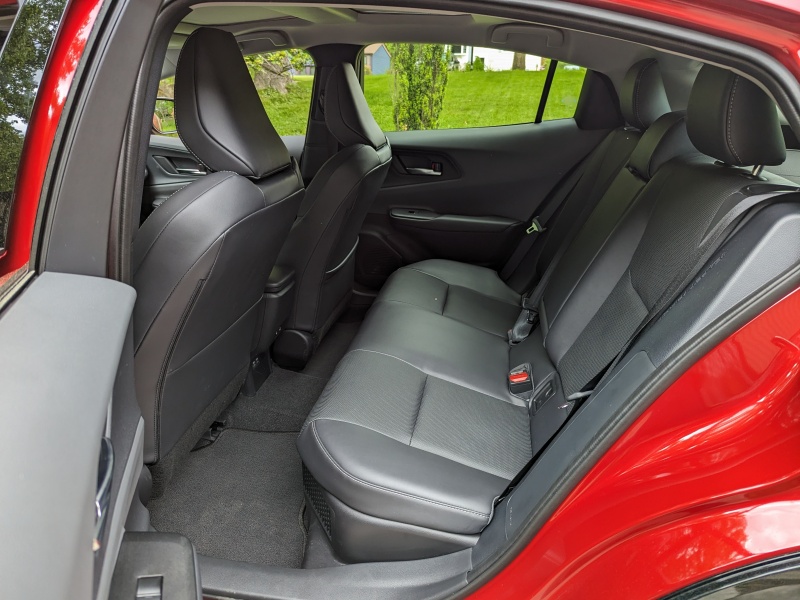
2024 Toyota Prius Limited ・ Photo by Brady Holt
Still Pretty Functional
The new Prius also has less cargo space than before. Last year, you could fit an SUV-like 27.4 cubic feet of luggage behind the backseat, while Toyota now quotes 23.8 cubic feet on the base model and just 20.3 cubic feet on the rest of the lineup.
This drop could disappoint Prius loyalists, but if you’re new to the model, that’s still pretty functional. The hybrid’s hatchback body still gives it more trunk space than any sedan, and you can fold down the backseat to expand the single open cargo hold. By comparison, a similarly sized Toyota Corolla Hybrid sedan has 13.1 cubic feet of trunk space. And while you can fold down its seats to let a few longer items pass through, you can’t fit bulky items the way you can in a hatchback.
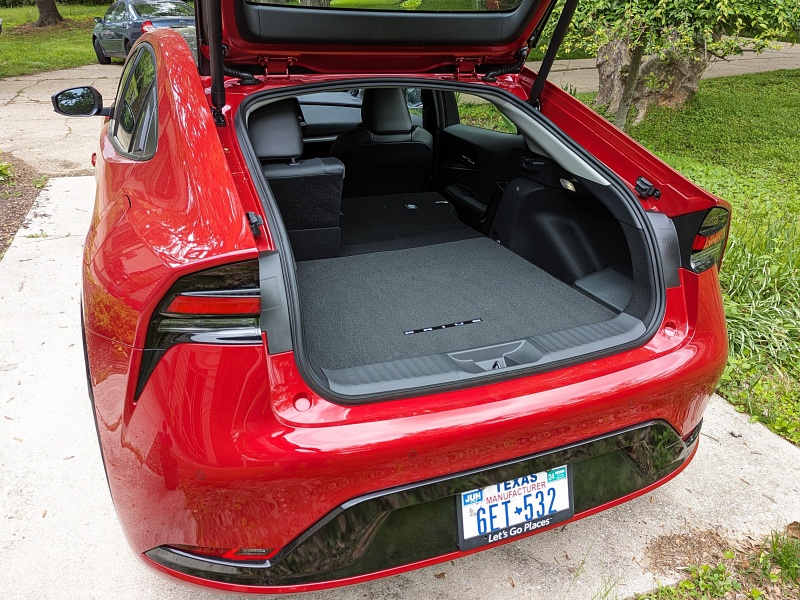
2024 Toyota Prius Limited ・ Photo by Brady Holt
Still Starts Well Under $30,000
The flashy, powerful Prius has gotten more expensive than before, but it’s still within reach of many budgets at a base price of $27,950. That price includes amenities like automatic climate control, adaptive cruise control, blind-spot monitoring, six USB-C ports, and 17-inch wheels, all of which cost extra on many compact cars.
The next level up is the XLE, $31,395. It’s another compelling value with synthetic leather upholstery, heating for the front seats and steering wheel, a power driver’s seat, a wireless smartphone charger, rain-sensing windshield wipers, and 19-inch wheels. It also lets you add a glass roof, a “digital key” (the ability to configure your smartphone to unlock and start the car), and the bigger touchscreen. Those options come standard on the top Limited, $34,965, which also adds a power liftgate, an eight-speaker JBL stereo, and ventilated front seats. AWD costs $1,400 extra on all trim levels.
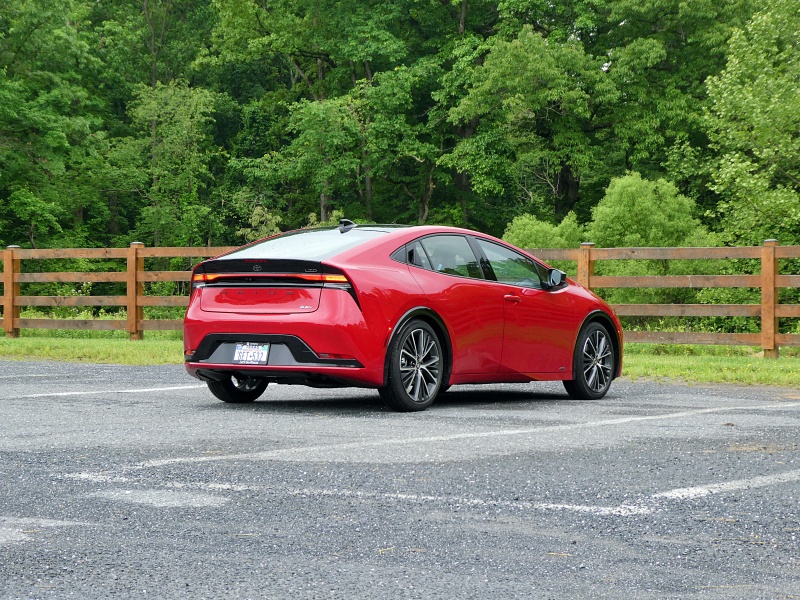
2024 Toyota Prius Limited ・ Photo by Brady Holt
Prius vs. the Competition
When you’re looking for a mix of incredible fuel economy and cargo space at an affordable price, the Prius’s closest current rival is the Kia Niro. Although Kia pitches the Niro as a crossover SUV, it’s more like a slightly taller hatchback. It’s not quite as quick or as economical as the new Prius, but it comes close in both ways while providing a more refined engine sound along with more passenger and cargo room. Ironically, although it’s the Kia that’s pitched as an SUV, only the Toyota offers optional all-wheel drive.
An even closer competitor, harkening back to the Prius’s early days on the market, is due out this summer: the 2025 Honda Civic Hybrid, bringing its own mix of speed and efficiency in both sedan and hatchback form. The Civic isn’t as slick-looking as the Prius, it won’t offer all-wheel drive, and early estimates call for slightly lower gas mileage, but the Honda has more room and nicer interior materials than the Toyota.
We’d also shop the Prius Hybrid against a couple of in-house rivals: the Toyota Corolla Hybrid and the Toyota Camry. The Corolla is essentially a more conservative-looking four-door version of the old Prius, without the new model’s extra style, power, and price tag. If you’re looking for affordable fuel efficiency and super-simple controls, and don’t prioritize a big cargo hold, it’s a winner. The new Camry mid-size sedan, now sold exclusively as a hybrid, is bigger and more refined than the Prius while costing only a little more and getting only slightly worse gas mileage; the Camry also has less cargo space. Meanwhile, the compact Hyundai Elantra Hybrid – priced between the Corolla Hybrid and the Prius – beats the former’s speed, refinement, and flash.
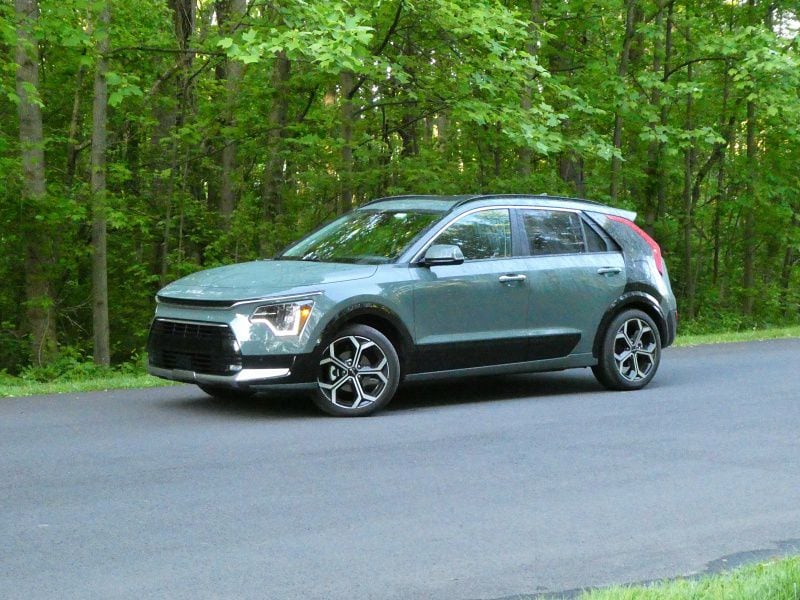
2023 Kia Niro Hybrid ・ Photo by Brady Holt
The Prime Alternative
The Prius we’re reviewing today isn’t the most efficient member of the Prius family. That honor goes to the Toyota Prius Prime, a plug-in hybrid. That means it has a bigger battery that you can charge up using electricity from the grid, which is enough to give it an EPA-estimated 40 to 45 miles of fully electric driving per charge (depending on the trim level). Once that range is used up, it drives like a regular Prius hybrid.
This package costs about $5,000 more than a standard Prius hybrid, but it could be worth it if you typically drive less than 40 miles per day and have a convenient place to plug in. Running on solely electricity costs less than burning gasoline, and by charging at home, you’d rarely need to stop at the gas station. You might also find an excellent lease deal on the Prius Prime due to tax incentives that favor leases on certain plug-in vehicles, including this Toyota.
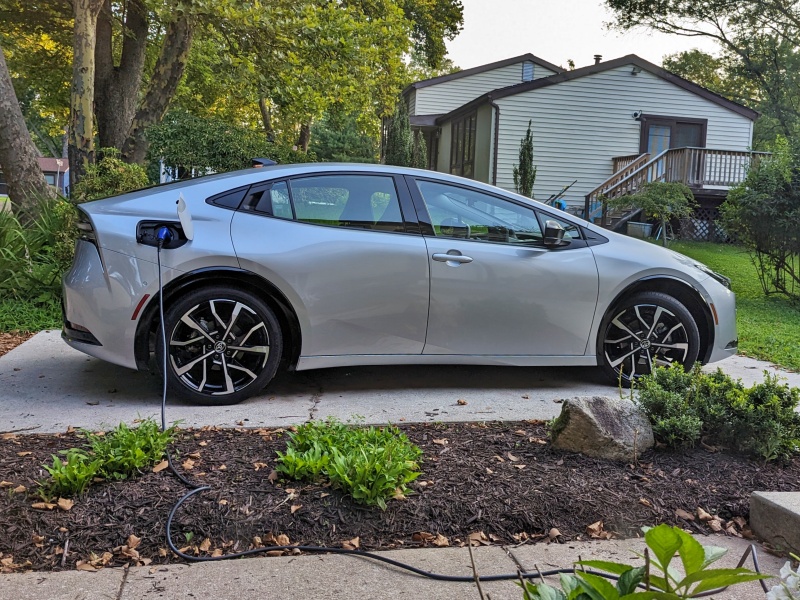
2023 Toyota Prius Prime ・ Photo by Brady Holt
A Different Sort of Prius
Toyota labels the latest Prius as “hybrid reimagined,” imprinting this text right on the car. That goes a bit far. Toyota isn’t the first automaker to combine beauty, speed, and gas-electric efficiency. But it’s certainly a new combination for the Prius, one that broadens the car’s appeal to folks who’d never previously found it attractive to look at or speedy enough.
On the other hand, its devoted but shrinking band of loyalists might pine for the old car’s everyday basics: extra space, a rear wiper, and more affordable replacement tires. And especially if you’re attracted to the silent speed of a fully electric car, the Prius’s groaning gas engine – quick or not – is a clear demerit. But a hybrid is a low-effort way to cut your gas bill, and the 2024 Toyota Prius is an appealing way to do so.

2024 Toyota Prius Limited ・ Photo by Brady Holt